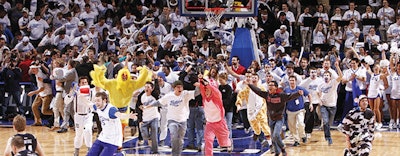
More than 20 years have passed since the infamous "Camp Randall Crush," the 1993 field-storming by University of Wisconsin students after a win over Michigan that left more than 70 fans injured. Response to the incident by the school and its hired security team was widely criticized, resulted in 15 lawsuits and put the spotlight on crowd control procedures at stadiums and arenas.
A 2010 field-storming at Camp Randall after an upset of No. 1-ranked Ohio State resulted in only one injury.
The issue of court-storming in college basketball was thrust back into the spotlight last spring after Duke head coach Mike Krzyzewski criticized the handling of the situation after an upset loss to Virginia, claiming his players were endangered by onrushing fans. The Atlantic Coast Conference reevaluated its crowd management policies, as it does on a yearly basis, and concluded that all was well with the current system. "Our schools have asked for the ability to manage that themselves," says Karl Hicks, the ACC's associate commissioner overseeing basketball. The league's policies prohibit any unauthorized personnel on the court "before, during or after a game," says Hicks, but leaves it up to its individual member schools to handle situations as they see fit.
"They're not promoting storming the court," says Hicks. "They feel that trying to prevent kids from coming on the court can be more hazardous than allowing them to go on. They want to manage the safety of their student-athletes in a way that works best for them."
Indeed, one of the criticisms surrounding the Camp Randall Crush and other court- and field-storming incidents is that the damage done to students and property could have been avoided or greatly reduced if event managers had given way and allowed the students to rush the field of play. That doesn't mean that game-day staff should just stand back and let the fans stampede the court. "Whenever you have kids storming onto the court, it is a potentially unsafe situation and you have to be careful," says Hicks. "You have to staff it, make sure you have security, first aid personnel."
STORM WATCH
Mike Caruso, associate athletic director for events and game operations at Texas A&M, has seen his fair share of incidents during his 25 years with the department, enough to recognize when conditions are right for a storming to occur. "It's a significant win of one kind or another," he says. "A rival game, upset situation. Students want to go out and celebrate, and almost 100 percent of the time, they head right to the middle of the court."
Hicks says he's able to anticipate a court storming 80 to 90 percent of the time, which is essential to successfully stopping an incident before it starts. Once the crowd's level of excitement gets too high, there's nothing game-day crews can do to tone it down. "You have to be proactive," emphasizes Caruso. "You can't be reactive."
In addition to recognizing in advance the matchups most likely to create a stir of excitement, game-day operators should also be actively monitoring the energy of the crowd throughout the game. "A huge area here is monitoring social media," says Caruso. "Fans will be talking about it. We have face-to-face communications but also monitor it from a social media standpoint — what's the crowd mentality, what are they talking about? If we think that there is potential, we start to communicate with the students: 'Wait for the team to come to you, don't get on the court.' We try and have a dialogue with fans."
Whatever administrators do, just don't tell fans they're not allowed to storm, says Caruso. "I've been places where they make that announcement," he says. "That just encourages fans more than it discourages them."
Even the no-tolerance approach of the Southeastern Conference isn't enough to deter a crowd of revelers. The conference fines schools $5,000 for a first offense, $25,000 for a second and $50,000 for a third. South Carolina racked up its first fine in 2005, following it with a $25,000 fine in January 2010 — both upset wins over ranked Kentucky.
Once the fan energy has reached that breaking point, he says, there's nothing to do but let them go. "When you talk to law enforcement, too, they say that the use of force is the last thing that they want to do," he adds. "Trying to prevent someone could cause more bodily injury than it would be to allow them. If we can prevent it, that's number one. If it's not preventable, let's make sure we get the visiting team and officials off the court safely."
EVACUATION PROCEDURES
Whatever an athletic program's official stance is on court storming, a Plan B should always be in place. "Be on guard, meet with the visiting team's director of operations, visit with your officials ahead of time and let them know how it's going to go," says Hicks.
First and foremost, get the officials and opposing teams off the floor and out of the way. "When it's a rush situation, most normal after-game protocol is abandoned," says Caruso. "Coaches may still shake hands, but the home team goes to celebrate and you don't do the normal sideline handshake."
Court-storming at Texas A&M was a bit more common before the school joined the SEC in 2012, but Caruso's team was well prepared. "Our strategy was two-fold: Protect the visiting team and coaches, and protect the officials," he says. "We had a person assigned to every official, and then had our staff form a human barricade in front of the visiting team bench so they had a clear exit path to get from their bench area to the locker room."
Sometimes actual police officers are charged with escorting officials from the court, as well. Whatever the strategy, it needs to be communicated with officials and visiting teams beforehand. At one game, recalls Caruso, the fans took to the court before the officials had time to get away safely. "The officials saw everybody coming and allowed fans to come on where they were supposed to exit," he says. "They just sat down at the scorer's tables."
Facility design elements can aid in directing crowd traffic, as well. Bike racks on the court limit where fans can go, for example. "Physical barriers set a clear definition that this is a safe path," says Caruso. "We have courtside chairs and tables that limit anyone to just a couple of avenues to get on the court. We monitor that area and keep it as safe as possible." In outdoor stadium design, high walls and even hedges discourage fans from using non-designated means to access the field.
THE AFTERMATH
For all the planning that goes into crowd control, just as much attention should be given to evaluating the outcome. "What we do and what we have done historically is manage the process with our game-day management teams and put together best practices and communicate," says Hicks. "Every other year I visit the schools directly and my supervisor of officials talks with the teams about official changes, I talk about sportsmanship, and we talk with the game-day managers about a whole host of operations."
The ACC's system has been effective thus far, with minimal incidents of fan injury and facility damage. As long as it stays that way, says Hicks, the tradition can stay, too. "If we felt our schools were not handling it in a responsible manner, other discussions would take place, but that hasn't been the case."
This article originally appeared in the January 2014 issue of Athletic Business under the headline, "Fandemonium."





































